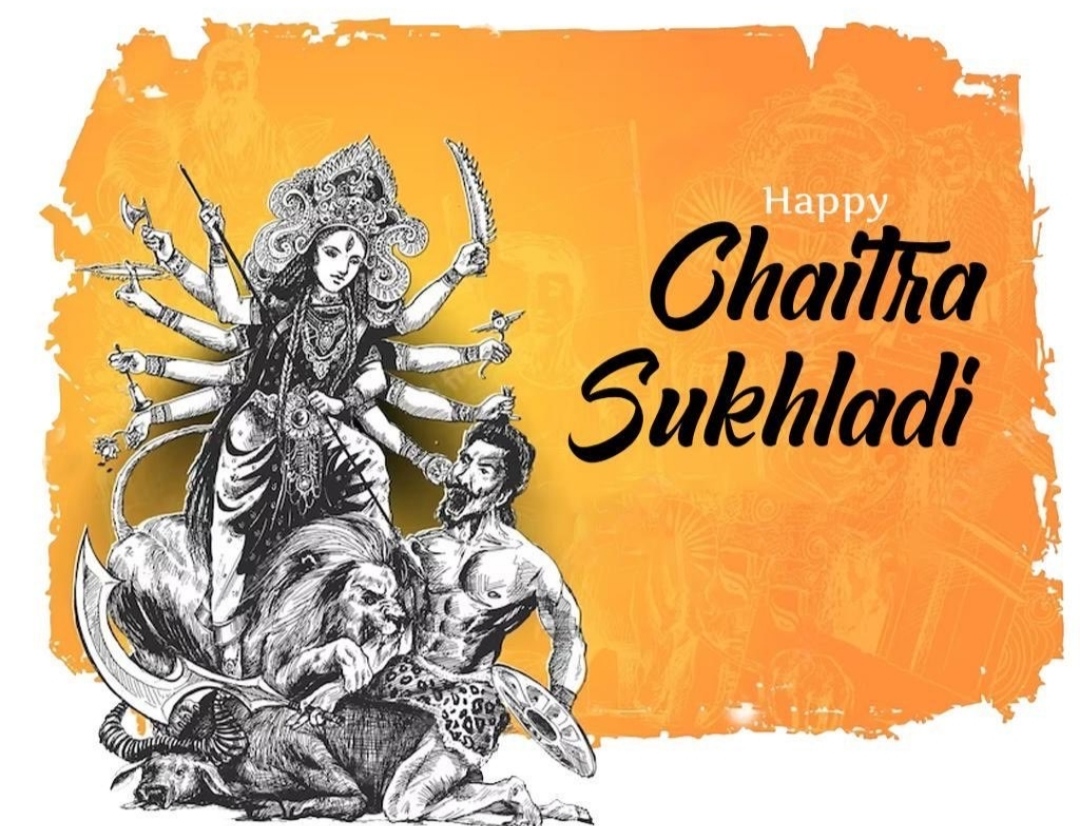
Chaitra Navratri 9 April, 2024,
Chaitra Navratri: – निश्चित रूप से! चैत्र नवरात्रि कुछ क्षेत्रों में, विशेष रूप से उत्तर भारत में, हिंदू नव वर्ष की शुरुआत का प्रतीक है, और इसका समापन नौवें दिन भगवान राम के जन्मदिन राम नवमी के साथ होता है। नवरात्रि का प्रत्येक दिन देवी दुर्गा के एक अलग रूप को समर्पित है, जैसे शैलपुत्री, ब्रह्मचारिणी, चंद्रघंटा, कुष्मांडा, स्कंदमाता, कात्यायनी, कालरात्रि, महागौरी और सिद्धिदात्री।
इन नौ दिनों के दौरान, भक्त उपवास करते हैं, पूजा करते हैं, भजन और प्रार्थना करते हैं और संगीत और नृत्य जैसे सांस्कृतिक कार्यक्रमों में भाग लेते हैं। यह आध्यात्मिक चिंतन, नवीनीकरण और दिव्य स्त्री ऊर्जा का आशीर्वाद प्राप्त करने का समय है।
चैत्र नवरात्रि धार्मिक महत्व के अलावा कृषि पद्धतियों से भी जुड़ी है। यह वसंत ऋतु की शुरुआत का प्रतीक है और इसे बीज बोने और नए उद्यम शुरू करने के लिए शुभ माना जाता है। कई लोग इस उत्सव की अवधि के दौरान अपने घरों को साफ करते हैं और सजाते हैं, दोस्तों और परिवार के साथ शुभकामनाओं और मिठाइयों का आदान-प्रदान करते हैं और धर्मार्थ गतिविधियों में संलग्न होते हैं।
यहां बताया गया है कि चैत्र नवरात्रि आमतौर पर कैसे मनाई जाती है:
- उपवास: कई भक्त नवरात्रि के दौरान सख्त उपवास रखते हैं, अनाज, शराब, प्याज, लहसुन और मांसाहारी भोजन का सेवन करने से परहेज करते हैं। कुछ लोग पूरी तरह से उपवास करना चुन सकते हैं, जबकि अन्य लोग फल, दूध और अन्य हल्के खाद्य पदार्थों का सेवन कर सकते हैं।
- प्रार्थना और पूजा: भक्त देवी दुर्गा और उनके विभिन्न रूपों की दैनिक प्रार्थना और पूजा (पूजा) करते हैं। इसमें मंत्रों का जाप करना, फूल, धूप और अन्य प्रसाद चढ़ाना और परमात्मा का आशीर्वाद पाने के लिए अनुष्ठान करना शामिल है।
- मंदिरों में जाना: लोग देवी दुर्गा को समर्पित मंदिरों में जाते हैं, विशेष रूप से वे मंदिर जो नवरात्रि उत्सव के लिए जाने जाते हैं। वे प्रार्थना करते हैं, आरती (रोशनी के साथ पूजा की रस्म) में भाग लेते हैं, और पुजारियों से आशीर्वाद मांगते हैं।
- नवरात्रि व्रत के खाद्य पदार्थ: व्रत के दौरान अनुमत सामग्री, जैसे कि कुट्टू का आटा, सिंघाड़े का आटा, आलू, शकरकंद और फल का उपयोग करके नवरात्रि के दौरान विशेष व्यंजन तैयार किए जाते हैं। व्रत के दौरान इन व्यंजनों का सेवन किया जाता है।
- गरबा और डांडिया रास: कई क्षेत्रों में, विशेष रूप से गुजरात और महाराष्ट्र में, लोग गरबा और डांडिया रास नृत्य में भाग लेने के लिए शाम को इकट्ठा होते हैं। इन पारंपरिक लोक नृत्यों में देवी दुर्गा को समर्पित संगीत और गीतों के साथ लयबद्ध चाल, ताली बजाना और छड़ी के साथ नृत्य करना शामिल है।
- सांस्कृतिक कार्यक्रम: त्योहार के सांस्कृतिक महत्व का जश्न मनाने के लिए नवरात्रि के दौरान संगीत समारोह, भजन (भक्ति गीत) प्रदर्शन और आध्यात्मिक प्रवचन सहित विभिन्न सांस्कृतिक कार्यक्रम आयोजित किए जाते हैं।
- धर्मार्थ गतिविधियाँ: कुछ भक्त नवरात्रि के दौरान दान और सामुदायिक सेवा के कार्यों में संलग्न होते हैं, जैसे कम भाग्यशाली लोगों को भोजन, कपड़े या धन दान करना।
- घर की सजावट: नवरात्रि के दौरान उत्सव का माहौल बनाने के लिए घरों को अक्सर फूलों, रंगोली (फर्श पर बनाए गए कलात्मक डिजाइन) और रोशनी से सजाया जाता है।
कुल मिलाकर, चैत्र नवरात्रि भक्ति, उत्सव और आध्यात्मिक विकास का समय है, जिसे दुनिया भर के हिंदू उत्साह और उमंग के साथ मनाते हैं।
चैत्र नवरात्रि के कई महत्व हैं:
- आध्यात्मिक नवीनीकरण: यह भक्तों के लिए उपवास, प्रार्थना और ध्यान के माध्यम से अपने मन और शरीर को शुद्ध करने, आध्यात्मिक विकास और नवीनीकरण को बढ़ावा देने का समय है।
- दिव्य स्त्रीत्व की पूजा: नवरात्रि देवी दुर्गा के विभिन्न रूपों का सम्मान करती है, जो बुराई पर अच्छाई की विजय और दिव्य स्त्री ऊर्जा की शक्ति का प्रतीक है।
- सांस्कृतिक उत्सव: यह त्यौहार अनुष्ठानों, संगीत, नृत्य और सांस्कृतिक कार्यक्रमों के माध्यम से समुदायों को एक साथ लाता है, एकता और सद्भाव की भावना को बढ़ावा देता है।
- कृषि महत्व: चैत्र नवरात्रि वसंत ऋतु की शुरुआत का प्रतीक है, जो बीज बोने और नए उद्यम शुरू करने जैसी कृषि गतिविधियों के लिए शुभ समय है।
- पौराणिक महत्व: हिंदू पौराणिक कथाओं के अनुसार, चैत्र नवरात्रि राक्षस राजा रावण पर भगवान राम की जीत के साथ-साथ भैंस राक्षस महिषासुर पर देवी दुर्गा की जीत का जश्न मनाती है।
कुल मिलाकर, चैत्र नवरात्रि दुनिया भर के हिंदुओं के लिए आध्यात्मिक चिंतन, सांस्कृतिक उत्सव और दिव्य स्त्री ऊर्जा को अपनाने का समय है।
In English
Siddhidatri.
During these nine days, devotees fast, perform puja, recite bhajans and prayers and participate in cultural programs such as music and dance. It is a time of spiritual reflection, renewal and receiving the blessings of the divine feminine energy.
Apart from religious significance, Chaitra Navratri is also associated with agricultural practices. It marks the beginning of spring and is considered auspicious for sowing seeds and starting new ventures. Many people clean and decorate their homes during this festive period, exchange wishes and sweets with friends and family and engage in charitable activities.
Here’s how Chaitra Navratri is usually celebrated:
Fasting: Many devotees observe a strict fast during Navratri, abstaining from consuming grains, alcohol, onion, garlic and non-vegetarian food. Some people may choose to fast completely, while others may consume fruits, milk, and other light foods.
Prayers and Worship: Devotees offer daily prayers and puja (worship) to Goddess Durga and her various forms. It involves chanting mantras, offering flowers, incense and other offerings and performing rituals to seek divine blessings.
Visiting Temples: People visit temples dedicated to Goddess Durga, especially those temples known for Navratri celebrations. They pray, participate in aarti (worship ritual with lights), and seek blessings from the priests.
Navratri fast foods: Special dishes are prepared during Navratri using ingredients permitted during the fast, such as buckwheat flour, water chestnut flour, potatoes, sweet potatoes and fruits. These dishes are consumed during fasting.
Garba and Dandiya Raas: In many areas, especially in Gujarat and Maharashtra, people gather in the evening to participate in Garba and Dandiya Raas dance. These traditional folk dances involve rhythmic movements, clapping and stick dancing accompanied by music and songs dedicated to Goddess Durga.
Cultural Events: Various cultural events including concerts, bhajan (devotional song) performances and spiritual discourses are organized during Navratri to celebrate the cultural significance of the festival.
Charitable activities: Some devotees engage in acts of charity and community service during Navratri, such as donating food, clothes or money to the less fortunate.
Home Decoration: Homes are often decorated with flowers, rangoli (artistic designs drawn on the floor) and lights to create a festive atmosphere during Navratri.
Overall, Chaitra Navratri is a time of devotion, celebration and spiritual growth, celebrated by Hindus around the world with great enthusiasm and fervor.
Chaitra Navratri has many significances:
Spiritual Renewal: It is a time for devotees to purify their minds and bodies through fasting, prayer and meditation, promoting spiritual growth and renewal.
Worship of the Divine Feminine: Navratri honors the various forms of Goddess Durga, who symbolizes the victory of good over evil and the power of the divine feminine energy.
Cultural Festival: This festival brings communities together through rituals, music, dance and cultural programmes, promoting the feeling of unity and harmony.
Agricultural significance: Chaitra Navratri marks the beginning of spring, which is an auspicious time for agricultural activities like sowing seeds and starting new ventures.
Mythological significance: According to Hindu mythology, Chaitra Navratri celebrates the victory of Lord Rama over the demon king Ravana as well as the victory of Goddess Durga over the buffalo demon Mahishasura.
Overall, Chaitra Navratri is a time of spiritual contemplation, cultural celebration, and embracing the divine feminine energy for Hindus around the world.




